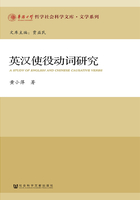
2.1 使役形式的定义
人或事物出现某种行为、变化和状态,可以是自身作用的结果,也可以是外在作用的结果。在后一种情况下,某一事物出现某种行为、变化和状态,总有另一人或事物施以外在之力。在这种外在之力联系下的两种事物的关系,表现到认知上,就是“使役”这一语义范畴(彭利贞,1997:17-23)。
使役形式可分为:1)起因突显(salient cause),施事导致受事做某事或处于某一状态;2)影响结果突显(salient effect),受事卷入带来状态变化的事件;3)感知突显(perceptual salient),含情态词的虚拟条件句表达的因果关系,包括真实意志和假设情形。 例如:
例如:
(1)Were I the president, I would support that policy. 〔subjunctive(hypothetical)主体的虚拟情态〕
(2)I insisted that you be quiet. 〔subjunctive(non-hypothetical)state主体的意向〕
Frawley(1992: 159)认为使役结构含一个导致进入一种状态的事件和一个结果(“a precipitating event”and“a result”), Shibatani(1976:1)认为使役构式(a causative construction)含一个致使事件(a causing event)和一个被使事件(a caused event)(转引自Dixon 2000: 30)。
Dixon(2000: 30)认为,使役构式中将一个具体点明的“使因”(causer)赋予一个基本的子句,“使因”指某人或某事物(该事物可以是事件或状态)发起或控制这项活动,这是“及物动词的主语/作施事的主语”(transitive subject/agent)句法语义功能的界定性特征。
Dixon的定义针对“使因”界定比较精细,但是有些使役构式中表层句法不见使因,使因隐没了的使役构式突显的是使因带来的结果。总之,使役构式有使因和结果,无论它们在表层句法显现与否。